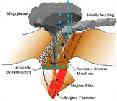
 |
| |
||||||||||||||||
|
|
NeMO's goal is to establish a multi-year monitoring and sampling program on Axial Volcano in order to examine the relationships between volcanic events and the chemistry and distribution of hydrothermal vents and the biologic communities that depend on them. |
||||

Why NeMO? The NeMO Project was conceived as a long-term study of the interactions between geology, chemistry, and biology on a dynamic part of the mid-ocean ridge system, using state-of the art technology. The goal is to make multiple observations at one location over several years to document changes in interrelated systems. Hence, the need for a multi-year seafloor observatory.
Axial volcano was chosen for the NeMO Project because it is the most volcanically active site on the Juan de Fuca Ridge. Indeed, within months after the NeMO Project was initiated and funded, an earthquake swarm and possible volcanic eruption occurred at Axial volcano in January 1998. The expeditions in previous summers have investigated that event. All this volcanism brings heat near the surface which can then be released in seafloor hot springs, called hydrothermal vents. These vents are oases for unique lifeforms based on chemosynthesis in which organisms derive energy by mediating chemical reactions within the hydrothermal fluids.
Scientists have also recently discovered that Earth hosts a subsurface biosphere of microbial life, but there is presently very limited understanding of its nature and extent. The NeMO approach is to conduct detailed studies of this active site over several years. Since prior observations indicate the subsurface biosphere is restimulated during volcanic eruptions or intrusions, microorganisms and their products normally residing at depth are brought up to the surface. Resulting snowstorms from these bacterial blooms can be sampled around hydrothermal vents. The NeMO Project also is an opportunity to share this exciting scientific research with teachers, students, and the general public. Each NeMO expedition has a teacher at sea and another teacher working onshore to help make research results available via this web site. Daily updates will be posted to the calendar page describing life at sea and scientific results during the expedition as well as answers to your questions during the cruise. Sound like fun? Join us for the next NeMO expedition.
|
| NeMO Home |About NeMO | Expeditions | NeMO Net | Explore | Dive! | Education |